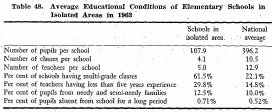| Home > Policy > White Paper, Notice, Announcement > White Paper > EDUCATIONAL STANDARDS IN JAPAN 1965 > CHAPTER |
||
In Japan, the number of public elementary schools in the areas defined as "Isolated", e.g. remote places in the mountains, far off islands and other secluded places with poor transportation services and natural, economic and cu1tura1 defects, accounts for 24% of all the public elementary schools, and the number of public lower secondary schoo1s in such areas is 21.2% of all schools at that level. The number of pupils in elementary and lower secondary schools in such isolated areas, amount respectively to 6.3% and 4.8% of the total number of pupils of those levels.

Genera11y speaking, most of the schools in isolated areas are of small size, and they consist of a single multi-grade-class. The per cent of younger and less-experienced teachers is higher in such schools than the averages throughout the country. The numbers of pupils from needy families and semi-needy families and pupils absent from school for a long period also show a fairly high rate in these areas, as compared with the national averages. There are 9.4% of elementary school children and 7.7% of lower secondary school pupils who go to these remote schools from a long distance, i.e. more thin four kilometers in the case of elementary school children and more than six kilometers for lower secondary pupils.
Schools in isolated areas are found more in such prefectures as Hokkaido, Kochi, Wakayama, Nagasaki, Ehime, Oita, etc. In particular, more than half of the elementary and lower secondary schools in isolated areas are located in Hokkaido.
In order to raise the educational standards in isolated areas under less-favourable conditions as compared with other areas, the Law for the Promotion of Education in Isolated Areas was enacted in 1954, and full-scale measures have been launched in accordance with its provisions.
With a view to securing the service of teachers in isolated areas, steps have been taken such as special training of teachers, construction of teachers' residences with the assistance of national grants, special allowances for teachers serving isolated areas, and special allowances for teaching of one-class schools and multi-grade-class schools. In-service teacher training has also been provided by holding special seminars and training courses.
To facilitate attendance of pupils, subsidies have been provided for the purchase of school buses and boats, and for the construction of dormitories to be attached to consolidated lower secondary schools in isolated areas. In 1964, subsidies were provided for the construction of dormitories for entrants to upper secondary schools from isolated areas. Also, assistance was given to lower secondary pupils and their families by national subsidies to cover all the expenses for board and room in dormitories of lower secondary schools in isolated areas, irrespective of the economic conditions of the pupils' families. For elementary school children from needy and semi-needy families, the arrangement has been made to accommodate them free of charge in the school dormitories.
To assist teachers in schools in isolated areas, the Ministry of Education prepares and distributes free of charge sample programs for teaching at single teacher schools and in multi-grade-classes, and is preparing a compilation of textbooks for multi-classes.
To improve facilities and equipment in schools in isolated areas, grants have been made for the construction of multi-purpose rooms to be used for physical education, music lessons, assemblies and social and adult education activities, for construction of an independent electric power plants, and to purchase television sets. Since the 1964 school year, subsidies have been provided for the purchase of magnetic tape recorders. These facilities and equipment are expected to bring about great improvement in teaching in schools in isolated areas.
In addition, special attention has been given to the improvement of facilities and equipment for health administration and school meals in these areas.
In 1964, the Law concerning Standards for Class Organization and Teacher Quota in Public schools of Compulsory Education was amended to fix the standard numbers of pupils per class in single-class schools at 15 for elementary schools, 25 for lover secondary schools, and 25 in both elementary and lower secondary schools with multiple grade classes. These standards have been put into effect since 1964, through which a foundation has been made for further promotion and improvement of education in isolated areas. In the 1964 fiscal year, l,864 million yen (about 5,180 thousand dollars)were appropriated in the national budget for the promotion of education in isolated areas. This is about ten times the budget for 1954 when the Law for Promotion of Education in Isolated Areas was established.
Thus, educational conditions in schools in isolated areas in Japan have gradua1ly been improved. The efforts made so far seems to be bearing rich fruit, as indicated by the results of the annual nation-wide scholastic achievement tests; the discrepancy in scholastic achievement between the pupils in isolated areas and those in other areas has been reduced, and among the schoo1s in isolated areas there are a number of schools securing high average school scores on these tests. However, the educational standard in most isolated areas is still far bellow normal, and further promotional efforts are urgently needed.
| Back to Top | MEXT HOME |